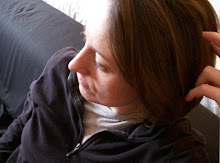Caucasian male, early 40s, with soft wavy brown hair, wearing a long dark wool coat and striped scarf wrapped tight around his neck. Ever patient, he's stuck riding the back step of the streetcar, even stepping off onto the street to let passengers by. He holds tight to the bar, keeping a pouty lip and flared nostrils of one who hopes to seem easygoing, because, secretly, he worries that people think he's in the way. He holds in his hand, page marked with an index finger, the book he had clearly intended to continue once aboard. When he finally does get a seat, he rides a stop, all of thirty seconds, closes the book and stands in line with the others as they file off into the work day. Books just do that to us. They make us want to not wait.
The Corrections, Jonathan Franzen (HarperCollins)
Page 188:
"Of course, chemistry, too, even brain chemistry," Eberle was saying, "is basically just manipulation of electrons in their shells. But compare this, if you will, to an electronics that consists of little two-and three-pole switches. The diode, the transistor. The brain, by contrast, has several dozen kinds of switches. The neuron either fires or it doesn't; but this decision is regulated by receptor sites that often have shades of offness and on-ness between plain Off and plain On..."The streetcar lingers. He's intent on reading, unaware that we're not moving. The driver is checking his mirror, waiting. An older man saunters up beside the car, his head level with the man in his seat, deep into the passage. The man outside wears a tattered baseball cap and down-filled jacket, stained. He carries a woman's purse high on his shoulder. His beard is matted and overgrown. I look down at his feet. He wears tan, thatched shoes. And he's shuffling. One step forward, to the side, two toe taps to the back. He's dancing, something honky tonk. The man on the streetcar is oblivious.
"...Even if you could build an artificial neuron out of molecular transistors, the conventional wisdom is that you can still never translate all that chemistry into the language of yes/no without running out of space..."We're all lining the windows now. The driver smiles. It's quite lovely, really. Suddenly no one seems to be in a hurry. One step forward, to the side, two toe taps to the back. We look around. The man outside isn't moving ahead. We begin to wonder if he's happy to stay where he is, dancing. The driver closes the door and begins to move forward, but the man outside seems ready to come up. But not so ready. He's moved ahead a foot and is starting the same routine over. Ritual. Our faces fall. We know he's somewhere else, but we're starting to wonder if he's, in fact, stuck. How many more rotations of this step does he need to perform before he makes it to the front of the shelter and up the steps? The driver reaches the same conclusion, closing the door. We lunge forward leaving the man behind, lost in his honky tonk, adjusting his purse higher on his shoulder.
"...If we conservatively estimate twenty neuroactive ligands, of which as many as eight can operate simultaneously, and each of these eight switches had five different settings--not to bore you with the combinatorics, but unless you're living in a world of Mr. Potato Heads, you're going to be a pretty funny-looking android."The man looks up from his book like he’s fresh from a catnap and rings the bell.

No comments:
Post a Comment